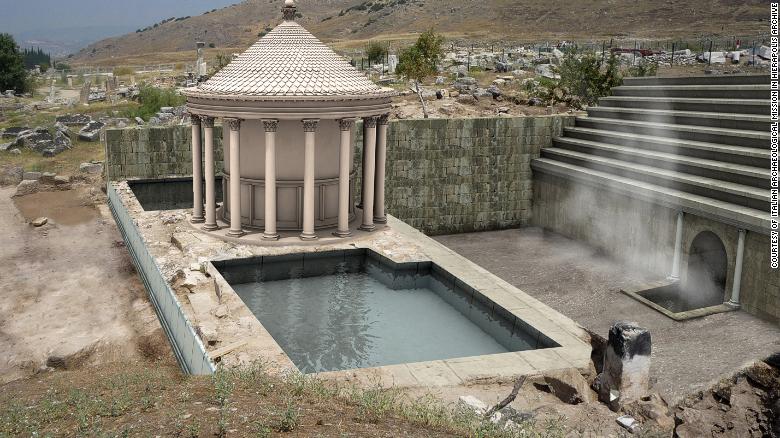via About History by Alcibiades

The Battle of Tannenberg, August 26-30, 1914 was between Russian and German troops during the East Prussian operation in the First World War.
The Schlieffen plan, which was the basis of the German strategy to win in the First World War, was created from the assumption that the Russian army would delay deployment for necessary mobilization. It was assumed that during this time the German army would be able to inflict heavy casualties in France and capture Paris, and then attack Russia. However, the Russian army unexpectedly mobilized quickly and created an offensive on the Eastern Front, thus putting Germany in a bad position.
Continue reading
==============================
via Boing Boing by David Pescovitz

digital rendering of the temple
Thousands of years ago in Hierapolis (now Turkey), tourists visited a temple named Plutonium built at a cave thought to be a gateway to the underworld. Magically, large and small animals would drop dead at the entrance to the cave while priest somehow survived. This isn't legend, it's reality. And now scientists have determined why.
Continue reading
==============================
via the Big Think blog by Scotty Hendricks
The history of women in brewing goes back millennia where it was a respected profession. How did it help give rise to our modern image of witches?
Billions of people enjoy a nice beer in the evening to unwind. Beer is the third most consumed beverage in the world after water and tea and has been an essential part of the human diet for at least 7000 years. Even for those of us who don’t like the stuff, the history of beer is a curious thing to study. Especially since it is Women’s History Month [it was when this was written] and the history of beermaking is primarily a history of women.
Continue reading
==============================
via Arts & Letters Daily: Jesse Norman in Spectator America

‘We have it in our power to begin the world over again.’ Ronald Reagan made this most unconservative of lines a leitmotif of his 1980 presidential campaign, knowing its radicalism would highlight his energy, personal optimism and desire for change. As it duly did.
The astonishing power over words of its author, Thomas Paine, persists to this day. In a letter of 1805, the former president John Adams said of Paine that
there can be no severer satyr on the age. For such a mongrel between pig and puppy, begotten by a wild boar on a bitch wolf, never before in any age of the world was suffered by the poltroonery of mankind, to run through such a career of mischief.Continue reading
==============================
via the OUP blog
The Anura order, named from the Greek an, ‘without’ and oura, ‘tail’, contains 2,600 different species and can be found in almost every continent on Earth. These are frogs, and they comprise 85% of the extant amphibian population on earth. They hop around our gardens, lay swathes of frothy eggs in our ponds, and come in a wide variety of exciting colours, but apart from that, how much do you really know about them?
Don’t be put off by their slimy skin and their associations with witchcraft. Ignore the fact that ‘frog-face’ is an insult, and that some frogs contain enough poison to kill two adult bull elephants. Frogs are amongst the oldest and most diverse vertebrates on our planet, and are truly incredible creatures. Learn more about them with 13 facts about frogs that you may not have already known. Why do some frogs have five legs? Why do some female frogs give out their own mating calls? And why do the French really get nicknamed ‘frogs’?
Continue reading
==============================
via Interesting Literature
A classic poem of parting
A. E. Housman (1859-1936) remains a popular poet with many readers not least because he so poignantly captures the feelings of heartbreak and hopeless love in his work. Technically, his poetry was not innovative: he once named the old ballads and the songs from Shakespeare’s plays as among his chief influences. But in English literature he is perhaps the Laureate of the Broken Heart: nobody has said it better. His short poem ‘Shake hands, we shall never be friends, all’s over’ is about parting from somebody we love, because we know they don’t return our love
Continue reading
==============================
via Boing Boing by Rob Beschizza

Earth Wind Map shows the winds blasting over a beautiful, rotatable 3D animated globe. Various modes (click the text on the bottom left) show air, oceanic, particulate and even auroral maps.
Absolutely fascinating. Watching the winds over the UK.
==============================
via the Big Think blog by Alastair Blanchard
The persistent dream of a “gay utopia” is one of the constants in gay and lesbian historical imaginings over the last 200 years. But is it real?
In recent years, we have seen significant advances won for LGBT rights through hard-fought legal cases and well-targeted political campaigns. Yet it is worth remembering that for decades, recourse to such methods was not available to LGBT people. The law-court and the parliament were deaf to their pleas. For many, it was only in their dreams that they could escape oppression.
Continue reading
==============================
via the OUP blog by Nicholas P Money

Bottling Prince Tuesday 2014 by Allagash Brewing. CC BY 2.0 via Flickr
From the dawn of history, human civilizations have prospered through partnership with the simple single-cell fungus we call yeast. It transforms sugars into alcohol, puffs up bread dough with bubbles of carbon dioxide, and is used to produce an assortment of fermented foods. It has become the workhorse of modern biotechnology as the source of life-saving medicines and industrial chemicals. And, most recently, the manufacture of ethanol as a biofuel from corn and sugarcane has launched yeast onto the frontline of our efforts to slow climate change by reducing carbon dioxide emissions.
Continue reading
==============================
via Interesting Literature
On Housman’s great ‘remorseful day’ poem
The poet and classical scholar A. E. Housman (1859-1936) is best-known for his 1896 volume A Shropshire Lad, one of only two volumes of poetry he published during his lifetime. But Housman wrote a number of other wonderful poems which he decided not to publish. ‘How Clear, How Lovely Bright’, written in the 1880s while Housman was living in London and working at the Patent Office after failing his degree in Classics at Oxford, was one of a number of poems which Housman preserved but didn’t publish. When he died in 1936, his brother Laurence selected the best of these poems and published them as More Poems.
Continue reading
No comments:
Post a Comment